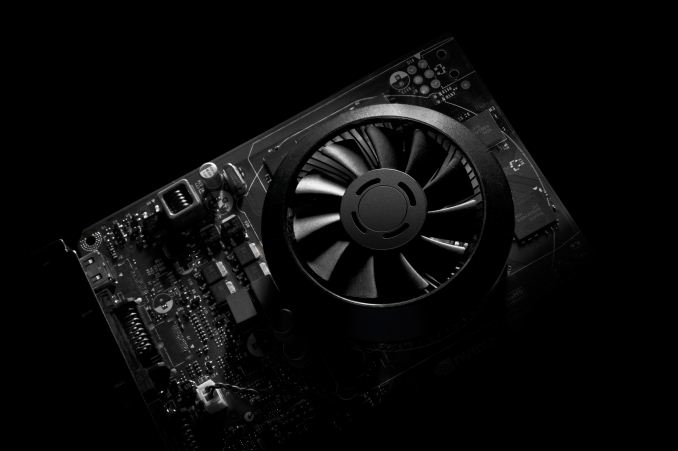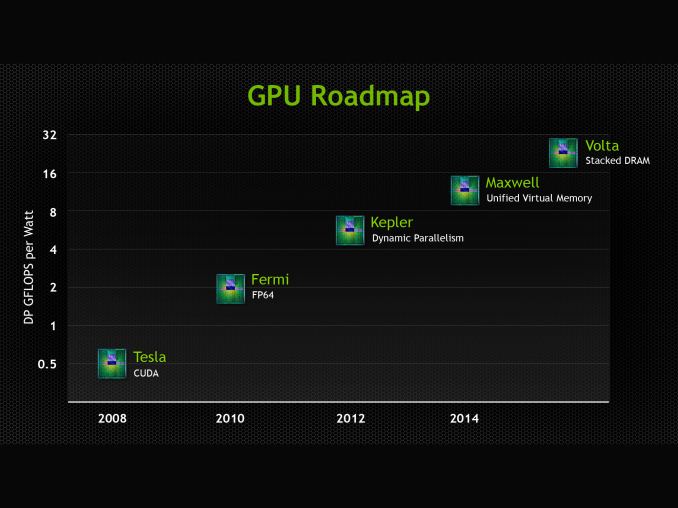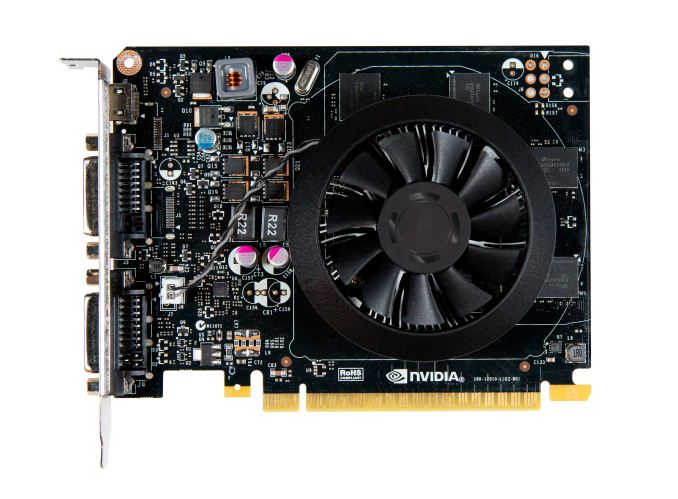The NVIDIA GeForce GTX 750 Ti and GTX 750 Review: Maxwell Makes Its Move
by Ryan Smith & Ganesh T S on February 18, 2014 9:00 AM EST
As the GPU company who’s arguably more transparent about their long-term product plans, NVIDIA still manages to surprise us time and time again. Case in point, we have known since 2012 that NVIDIA’s follow-up architecture to Kepler would be Maxwell, but it’s only more recently that we’ve begun to understand the complete significance of Maxwell to the company’s plans. Each and every generation of GPUs brings with it an important mix of improvements, new features, and enhanced performance; but fundamental shifts are fewer and far between. So when we found out Maxwell would be one of those fundamental shifts, it changed our perspective and expectations significantly.
What is that fundamental shift? As we found out back at NVIDIA’s CES 2014 press conference, Maxwell is the first NVIDIA GPU that started out as a “mobile first” design, marking a significant change in NVIDIA’s product design philosophy. The days of designing a flagship GPU and scaling down already came to an end with Kepler, when NVIDIA designed GK104 before GK110. But NVIDIA still designed a desktop GPU first, with mobile and SoC-class designs following. However beginning with Maxwell that entire philosophy has come to an end, and as NVIDIA has chosen to embrace power efficiency and mobile-friendly designs as the foundation of their GPU architectures, this has led to them going mobile first on Maxwell. With Maxwell NVIDIA has made the complete transition from top to bottom, and are now designing GPUs bottom-up instead of top-down.
Nevertheless, a mobile first design is not the same as a mobile first build strategy. NVIDIA has yet to ship a Kepler based SoC, let alone putting a Maxwell based SoC on their roadmaps. At least for the foreseeable future discrete GPUs are going to remain as the first products on any new architecture. So while the underlying architecture may be more mobile-friendly than what we’ve seen in the past, what hasn’t changed is that NVIDIA is still getting the ball rolling for a new architecture with relatively big and powerful GPUs.
This brings us to the present, and the world of desktop video cards. Just less than 2 years since the launch of the first Kepler part, the GK104 based GeForce GTX 680, NVIDIA is back and ready to launch their next generation of GPUs as based on the Maxwell architecture.
No two GPU launches are alike – Maxwell’s launch won’t be any more like Kepler’s than Kepler was Fermi’s – but the launch of Maxwell is going to be an even greater shift than usual. Maxwell’s mobile-first design aside, Maxwell also comes at a time of stagnation on the manufacturing side of the equation. Traditionally we’d see a new manufacturing node ready from TSMC to align with the new architecture, but just as with the situation faced by AMD in the launch of their GCN 1.1 based Hawaii GPUs, NVIDIA will be making do on the 28nm node for Maxwell’s launch. The lack of a new node means that NVIDIA would either have to wait until the next node is ready, or launch on the existing node, and in the case of Maxwell NVIDIA has opted for the latter.
As a consequence of staying on 28nm the optimal strategy for releasing GPUs has changed for NVIDIA. From a performance perspective the biggest improvements still come from the node shrink and the resulting increase in transistor density and reduced power consumption. But there is still room for maneuvering within the 28nm node and to improve power and density within a design without changing the node itself. Maxwell in turn is just such a design, further optimizing the efficiency of NVIDIA’s designs within the confines of the 28nm node.
With the Maxwell architecture in hand and its 28nm optimizations in place, the final piece of the puzzle is deciding where to launch first. Thanks to the embarrassingly parallel nature of graphics and 3D rendering, at every tier of GPU – from SoC to Tesla – GPUs are fundamentally power limited. Their performance is constrained by the amount of power needed to achieve a given level of performance, whether it’s limiting clockspeed ramp-ups or just building out a wider GPU with more transistors to flip. But this is especially true in the world of SoCs and mobile discrete GPUs, where battery capacity and space limitations put a very hard cap on power consumption.
As a result, not unlike the mobile first strategy NVIDIA used in designing the architecture, when it comes to building their first Maxwell GPU NVIDIA is starting from the bottom. The bulk of NVIDIA’s GPU shipments have been smaller, cheaper, and less power hungry chips like GK107, which for the last two years has formed the backbone of NVIDIA’s mobile offerings, NVIDIA’s cloud server offerings, and of course NVIDIA’s mainstream desktop offerings. So when it came time to roll out Maxwell and its highly optimized 28nm design, there was no better and more effective place for NVIDIA to start than with the successor to GK107: the Maxwell based GM107.
Over the coming months we’ll see GM107 in a number of different products. Its destiny in the mobile space is all but set in stone as the successor to the highly successful GK107, and NVIDIA’s GRID products practically beg for greater efficiency. But for today we’ll be starting on the desktop with the launch of NVIDIA’s latest desktop video cards: GeForce GTX 750 Ti and GeForce GTX 750.













177 Comments
View All Comments
TheinsanegamerN - Tuesday, February 18, 2014 - link
Look at sapphire's 7750. superior in every way to the 6570, and is single slot low profile. and overclocks like a champ.dj_aris - Tuesday, February 18, 2014 - link
Sure but it's cooler is kind of loud. Definitely NOT a silent HTPC choice. Maybe a LP 750 would be better.evilspoons - Tuesday, February 18, 2014 - link
Thanks for pointing that out. None of my local computer stores sell that, but I took a look on MSI's site and sure enough, there it is. They also seem to have an updated version of the same card being sold as an R7 250, although I'm not sure there's any real difference or if it's just a new sticker on the same GPU. Clock speeds, PCB design, and heat sink are the same, anyway.Sabresiberian - Tuesday, February 18, 2014 - link
I'm hoping the power efficiency means the video cards at the high end will get a performance boost because they are able to cram more SMMs on the die than SMXs were used in Kepler solutions. This of course assumes the lower power spec means less heat as well.I do think we will see a significant performance increase when the flagship products are released.
As far as meeting DX11.1/11.2 standards - it would be interesting to hear from game devs how much this effects them. Nvidia has never been all that interested in actually meeting all the requirements for Microsoft to give them official status for DX versions, but that doesn't mean the real-world visual quality is reduced. In the end what I care about is visual quality; if it causes them to lose out compared to AMD's offerings, I will jump ship in a heartbeat. So far that hasn't been the case though.
Krysto - Tuesday, February 18, 2014 - link
Yeah, I'm hoping for a 10 Teraflops Titan, so I can get to pair with my Oculus Rift next year!Kevin G - Tuesday, February 18, 2014 - link
nVidia has been quite aggressive with the main DirectX version. They heavily pushed DX10 back in day with the Geforce 8000/9000 series. They do tend to de-emphassize smaller updates like 8.1, 10.1, 11.1 and 11.2. This is partially due to their short life spans on the market before the next major update arrives.I do expect this to have recently changed as Windows it is moving to rapid release schedule and it'll be increasingly important to adopt these smaller iterations.
kwrzesien - Tuesday, February 18, 2014 - link
Cards on Newegg are showing DirectX 11.2 in the specs list along with OpenGL 4.4. Not that I trust this more than the review - we need to find out more.JDG1980 - Tuesday, February 18, 2014 - link
The efficiency improvements are quite impressive considering that they're still on 28nm. TDP is low enough that AIBs should be able to develop fanless versions of the 750 Ti.The lack of HDMI 2.0 support is disappointing, but understandable, considering that it exists virtually nowhere. (Has the standard even been finalized yet?) But we need to get there eventually. How hard will it be to add this feature to Maxwell in the future? Does it require re-engineering the GPU silicon itself, or just re-designing the PCB with different external components?
Given the increasing popularity of cryptocoin mining, some benchmarks on that might have been useful. I'd be interested to know if Maxwell is any more competitive in the mining arena than Kepler was. Admittedly, no one is going to be using a GPU this small for mining, but if it is competitive on a per-core basis, it could make a big difference going forward.
xenol - Tuesday, February 18, 2014 - link
I'm only slightly annoyed that NVIDIA released this as a 700 series and not an 800 series.DanNeely - Tuesday, February 18, 2014 - link
I suspect that's an indicator that we shouldn't expect the rest of the Maxwell line to launch in the immediate future.